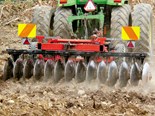Farmchief Quivogne NSL Grubber review



















|

|

|

|

|

|

|

|

|
While on a brief trip down south, Mark Fouhy caught up with the Farmchief team to test out their newly imported Quivogne NSL Grubber.
The paddock Paul (from Caldwell Contracting) had available for us to test the Farmchief Quivogne NSL grubber in had been in winter crop and recently grazed by cows, a standard policy over a number of years. To prepare for sowing again, ploughing has been the primary tillage option used. The rush to get paddocks ready and beat silage rush conditions may have been less than ideal at times, potentially causing some panning issues.
With the NSL grubber, this is not a problem, with tines doing the cultivating. It is a great option for grazed fodder or forage crops. Conventional ploughing may still be the best option for the cultivation of paddocks coming out of pasture to remove weed and pest issues. Another good point with the NSL grubber is that you don’t require years of ploughing experience to achieve a tidy effective job; the double row of wavy discs helps with that.
Not having too much pressure on the gangs of discs at the rear, the machine left the worked soil lifted between three and five inches after one pass. This allows air into the soil, lets the water out, and allows the contractors to get on with the next pass sooner. I was impressed with the finish after one pass with the NSL. Being a primary cultivation tool, the soil structure is not overworked, which increases in the chance of erosion and nutrient losses.
Operation
With my second experience of the Quivogne brand of cultivation machinery, I am going to say that simplicity and ease of use are two points which stand out from these machines. The machine tested this month is the Quivogne NSL grubber. Last month we had the Quivogne five leg deep ripper, which was great on those hard pans and wet areas needing drainage.
The NSL works on similar lines with an extra six legs, 11 in total to rip through the soil breaking up the compaction. Covering a greater area is possible with the 3m version (which Quvigone also manufactures in a 3.5m version) depending on conditions.
Operation at 7–10km/hr is pretty comfortable, especially when you have one of Caldwell Contracting’s 6190 John Deere tractors hooked on the front. Designed to work at a depth of 5–35cm, the high clearance between the frames of 820mm prevents soil from building up and flowing through to the wavy discs for further crumbling. The working depth is set with guide wheels on either side of the NSL grubber.
Up front, the wavy disc roller semi floats, with adjustment via pins to change the amount of pressure it will apply. If you apply too much downforce with the roller it will drag all the soil loosened by the tines with it, as we discovered when setting up for testing.

Construction
Build quality is important for any machine to be used in tillage applications. The leaf spring reset system of the NSL tines is a good time-saving feature. The chances of making it through most paddocks without hitting a hidden foreign object is pretty slim in most cases. I prefer this system on a tool like this over a shear bolt.
Replaceable tips on the tines are made from high-quality German steel. The main frame consists of twin beam 100mm x 100mm 8mm HLE micro alloy steel to offer strength without excessive weight. The use of high-grade steel allows them to keep the overall weight of the machine down (1250kg) while still providing the necessary strength required for such a machine.
The top linkage point has bracing back to the second row of tines to add strength and support to the weight of the dual wavy disc roller. Finished with the Quivogne bright red paint like a fire engine, it should stand up to years of hard work with minimal fuss and repairs.
The verdict
After a flying visit to the South Island, I have learned a lot about the French-made Quivogne brand of machinery, which is imported to New Zealand by Farmchief. The simplicity of design and solid construction of quality materials stands out and will always be a winner.
Pros
- Lifting and ripping of tines and rear discs do a great job.
- Simple to operate.
- Well-built, quality European machine.
Cons
- I’d like to see the addition of a tow hitch for light chain harrows.
Keep up to date in the industry by signing up to Farm Trader's free newsletter or liking us on Facebook




.jpeg)










